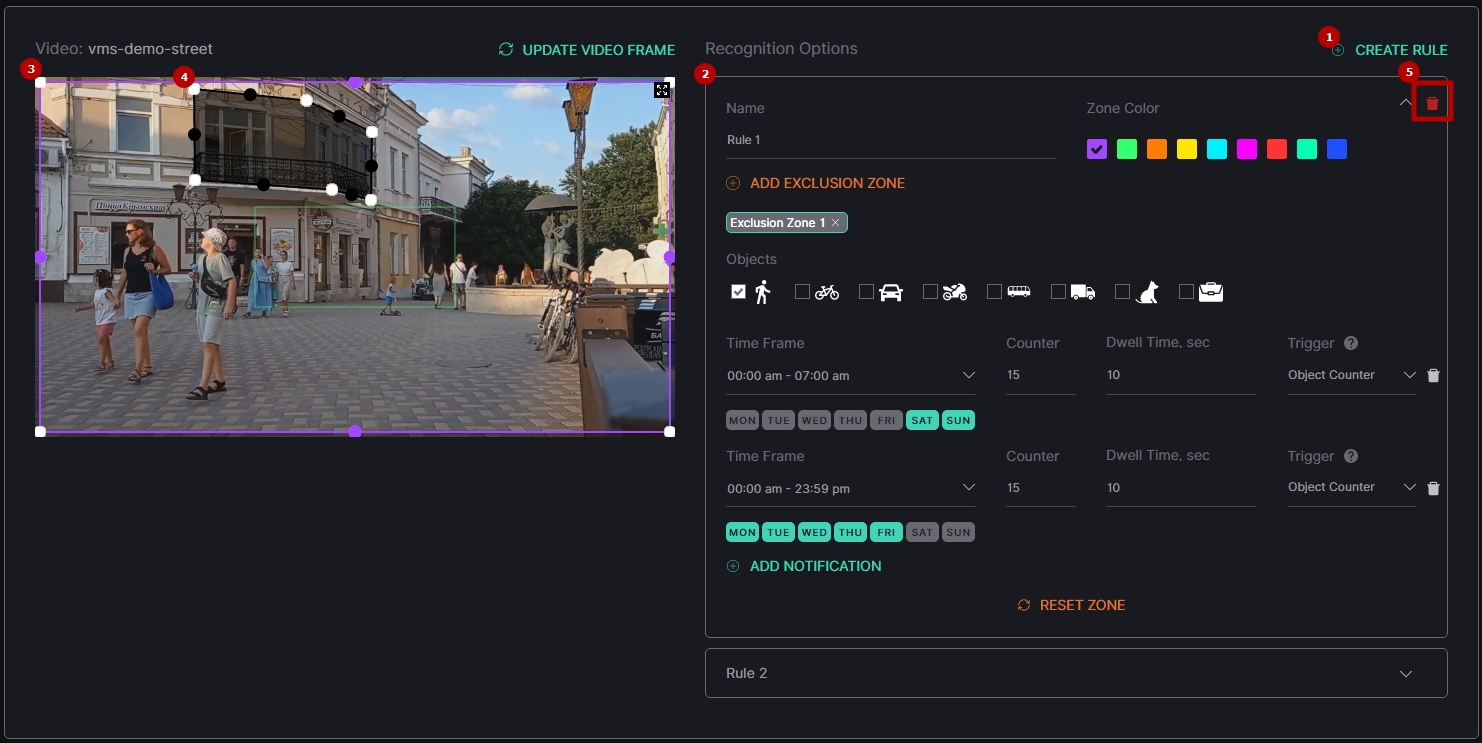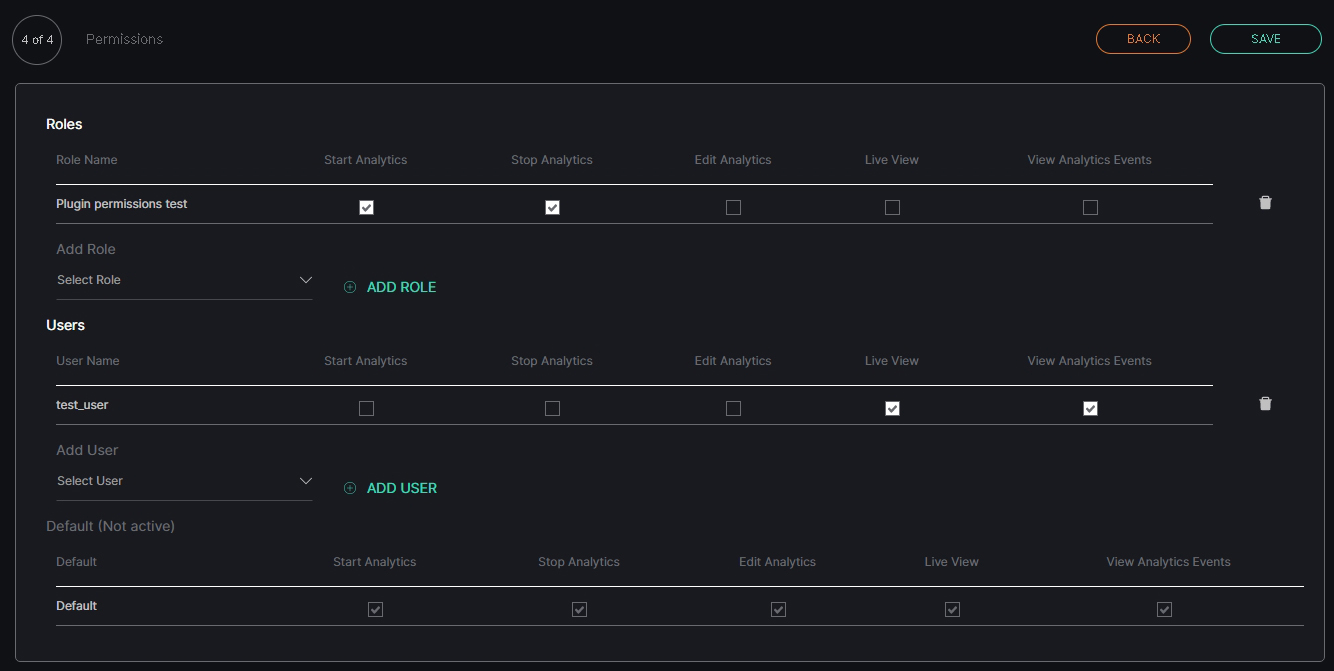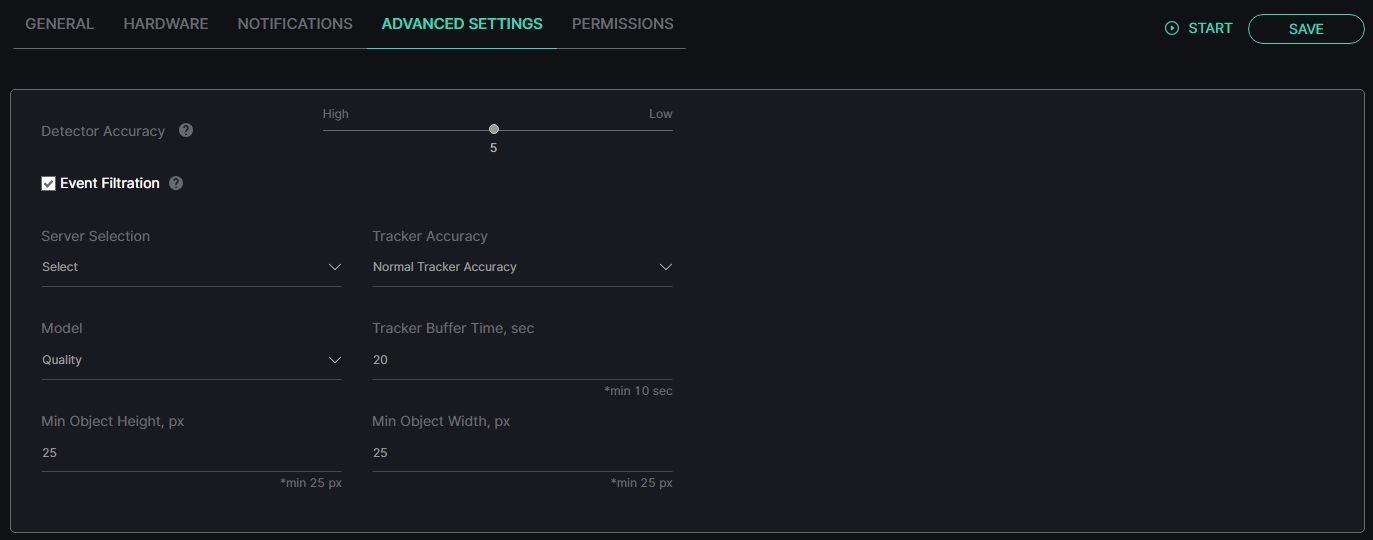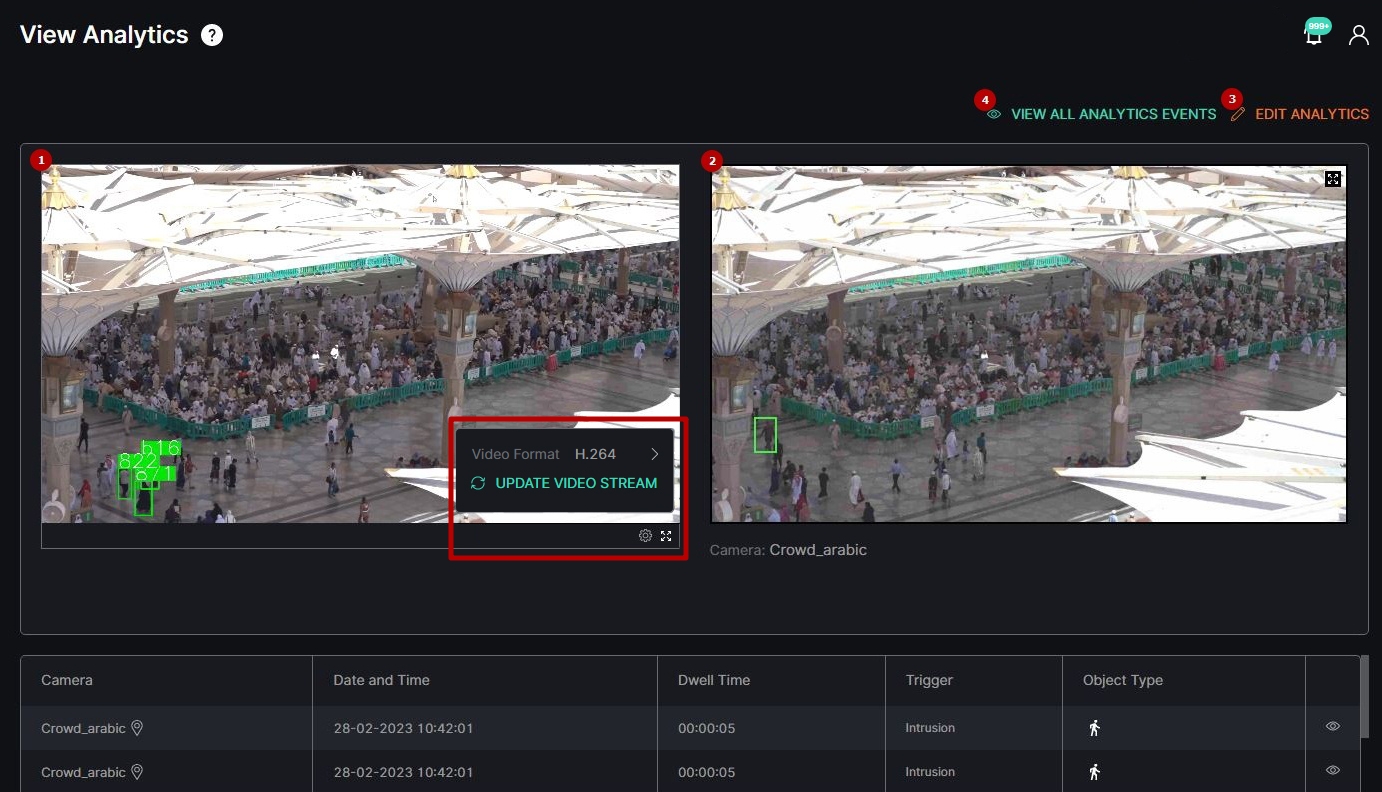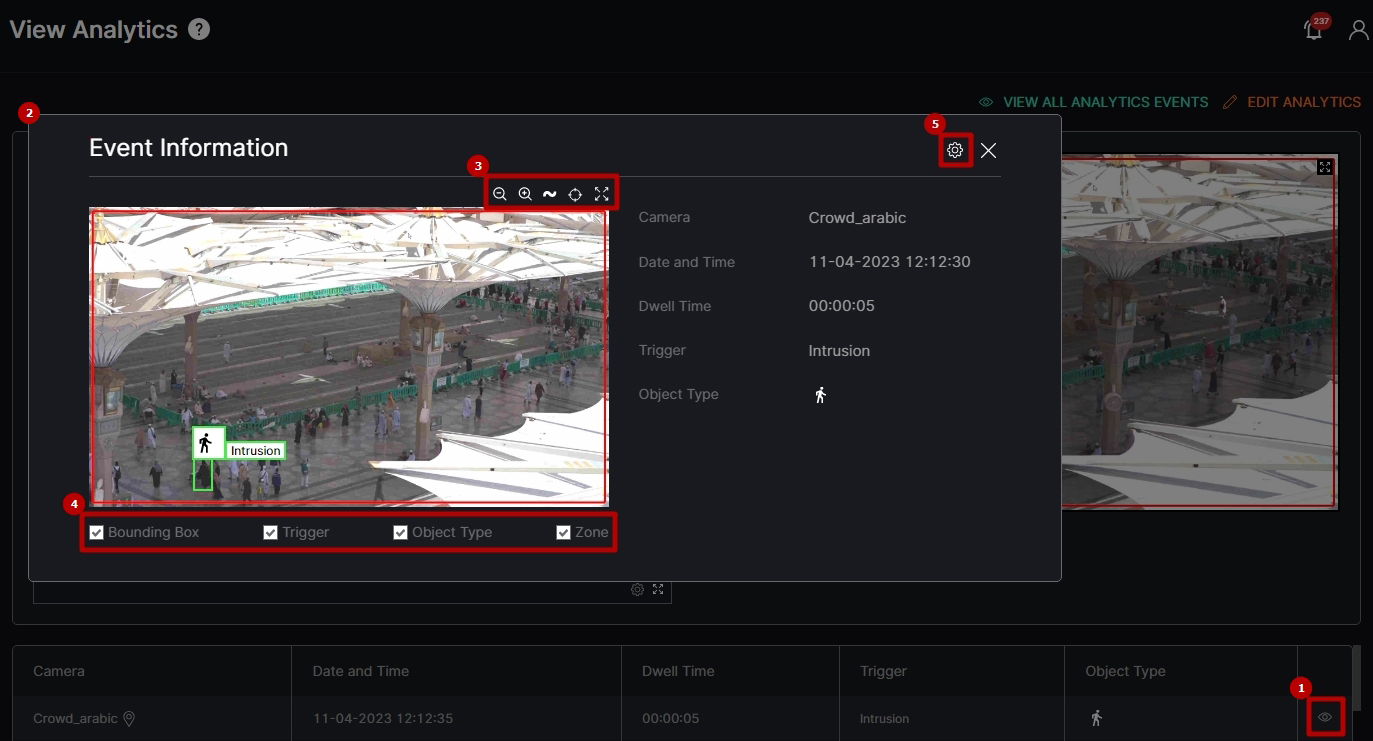Object Detection: Analytics
Overview
To open the Analytics item, in the left menu:
- Select the Object Detection section
- Choose the Analytics item
- See analytics
Use and Functionality
The Object Detection Analytics functional menu allows to:
- Fill in the Camera field with:
- Camera name or characters in the name
- Analytics ID
- Video stream ID
- Select the required analytics status
- Click the Reset button to clear the filters
See the list of analytics in the table below. It contains:
- Analytics and folders ID
- Camera comprises:
- Folders' and separate video streams' names
- Copy Name icon to copy the video stream name
- Video source type
- Additional hardware parameters
- Video stream or video file playback status. For the Active and Offline statuses, the system also displays:
- Countdown since analytics launch
- Last server connection to analytics (seconds ago)
- Toolbox comprises:
- Start/Stop
- Edit
- Events
- View
- Delete
- To learn more about grouping video streams into folders and making the appropriate changes in the Video Streams item, read Video Streams.
- To find out the ID of the CPU/GPU and the server running the video stream, hover the mouse over the circle next to the status of the running analytics.
Create Analytics
To create new analytics, click the Create Analytics button:
The Create Object Detection Analytics navigation menu allows to:
- Click the Back to All Analytics button to return to the main Analytics item
- See the title and serial number of the current tab
- Click the Back or Next button to move among tabs:
- General
- Hardware
- Notifications
- Permissions
General Tab
The General tab provides the ability to set a video stream and customize analytics parameters.
To set a video stream:
- Click the Video field
- See the Set Video Stream pop-up window
- Fill in the Search field with:
- Camera name or characters in the name
- Video stream ID
- Select the required camera from the filtered list
- Click the Set Video Stream button to confirm the intention
Recognition Options
- In Zone trigger type executes if an object of the selected type entered the empty detection zone (or initially occupied it) and was within it for the specified time.
- Out of Zone trigger type executes if the object leaves the detection zone and stays outside for at least the specified time. The trigger does not execute if at least one object is still in the detection zone. The trigger executes only when the detection zone is completely empty.
- Object Counter trigger type calculates the number of simultaneously detected objects in the detection zone. It triggers provided that the number of objects in the detection zone is greater than or equal to the specified parameter.
- Presence Control trigger type is executed with the In Zone tag for each object that enters the detection zone (or initially occupies it) and remains within it for the specified dwell time. The trigger is then executed again with the Out of Zone tag when the same object leaves the detection zone and stays outside for the specified dwell time. This scenario is applied separately to each detected object.
- Intrusion trigger type executes if an object entered the detection zone and was inside it for the specified time.
- Crowd trigger type calculates the number of simultaneously detected Person objects within a detection zone over a set duration. The trigger considers the distance between Person objects to identify people gatherings and executes when the specified crowd density threshold is met or exceeded.
To learn more about triggers and view the examples of their use, read Triggers.
To perform the recognition, apply these recognition options:
- Select the Create Rule button to create a new rule
- Set the notification parameters:
- Enter the rule name
- Select the color of the detection zone
- Select the required checkboxes to set objects:
- Person
- Bicycle
- Car
- Motorcycle
- Bus
- Truck
- Animal (dogs and cats)
- Bag
- Select the required time frame to specify the analytics working hours
- Set the detection time in seconds for the Dwell Time, sec parameter
- Set the amount of the required objects for the Counter parameter
- Select the notification trigger type:
- In Zone
- Out of Zone
- Object Counter
- Presence Control
- Intrusion
- Crowd
- Select days of the week to receive the specified notifications
- Click the Add Notification button to create multiple sets of notification parameters
- Click the white Delete icon to delete the set of notification parameters
- Modify the detection zone:
- Click and drag the handles with LMB to set the zone borders
- Click and drag the area inside the zone with LMB to move the whole zone
- Click the handle with RMB to delete it
- Click the Reset Zone button to return the detection zone borders to their original position
- Modify the exclusion zone:
- Click the Add Exclusion Zone button to add up to 3 exclusion zones in each rule
- Click and drag the handles with LMB to set the exclusion zone borders
- Click and drag the area inside the zone with LMB to move the whole exclusion zone
- Click the handle with RMB to delete it
- Click the Close button next to the required exclusion zone name to remove it
- Select the red Delete icon to delete the required rule section
- All days of the week are selected by default. Buttons become grey when deselected.
- The Counter parameter becomes available only for the Object Counter and Crowd trigger types.
- The detection and exclusion zones are based on at least 3 handles.
- Sets of notification parameters within one rule differ only by Time Frame and days of the week. Counter, Dwell Time, and Trigger parameters duplicate in all sets and can be changed only in the very first set, which leads to similar changes in all further sets.
Hardware Tab
The Hardware tab provides the ability to customize hardware parameters:
- Choose the CPU or GPU hardware acceleration
- Select the hardware decoder from the drop-down list:
- CPU
- Intel
- NVDEC
- Select the FPS frame processing mode to set the desired number of frames per second
- The recommended value for the FPS mode is 25.
- The Key Frame and Once Every X Seconds options are disabled for the Object Detection analytics.
- The default parameters allow the production of analytics. To customize the analytics, set parameters as required.
- To learn more about hardware settings, read How to Сonfigure the Hardware Tab Settings.
Notifications Tab
The Notifications tab allows managing the event notifications:
- Check the Internal Notification box to allow the system to send all notifications to the Events section
- Check the Send Events to Event Manager box to allow the system to send all notifications to the Event Manager and then to external resources
Once the Internal Notification box is checked, and the analytics is created and enabled, the Notification icon signals about each new event notification. Click the Notification icon to open the Notification Panel. It comprises:
- Plugin name box to:
- Collapse/expand the list of event notifications by clicking the plugin name
- Clear all plugin event notifications at once from the Notification Panel by clicking the Close button (this action doesn't affect events in the Events item)
- Event notification box to:
- View short event information and frame preview for up to 3 last notifications
- Open the event pop-up window by clicking the required notification
- Clear the desired event notification from the notification list by clicking the Close button inside the box (this action doesn't affect the event in the Events item)
- Show More button with the total events number to open the Events item and view all events
Permissions Tab
The Permissions tab provides the ability to:
- Assign analytics access rights for Roles:
- Select the required role from the drop-down list
- Click the Add Role button
- Select the checkboxes for the required access rights
- Click the Delete icon to remove the unnecessary role
- Assign analytics access rights for Users:
- Select the required user from the drop-down list
- Click the Add User button
- Select the checkboxes for the required access rights
- Click the Delete icon to remove the unnecessary user
- Select the checkboxes for the required analytics access rights by default
- Select the Save button to confirm the intention in the navigation menu
- The default parameters are active only if no Roles or Users are added.
- The quantity of added Roles and Users is not limited.
Once saved, the Object Detection Analytics editor opens to allow the users to:
- Modify parameters
- Set parameters
- Run the created analytics
- Proceed to live view mode
Edit Analytics
To edit settings in the selected analytics, click the Edit icon on the toolbox:
The Edit Object Detection Analytics navigation menu allows to:
- Click the Back to All Analytics button to return to the main Analytics item
- See the setting tabs and move among them by clicking their titles:
- General
- Hardware
- Notifications
- Advanced Settings
- Permissions
- Select the Stop button to disable the analytics:
- Yes to confirm the analytics disabling
- No to cancel the intention or close the pop-up window
- Select the Start button to enable the analytics
- Click the Live View button to see the selected analytics process in real-time
- Select the Save button to apply the changes to the selected analytics
- The current tab is always highlighted.
- Analytics editing is available only when selected analytics is disabled.
- The Stop button is available only when the current analytics is active.
- The Start button is available only when the current analytics is stopped.
- The Live View button is available only when the current analytics is active.
To view editing parameters for the General, Hardware, Notifications, and Permissions tabs, read Create Analytics.
Advanced Settings Tab
The Advanced Settings tab allows the users to:
- Move the slider to the left (to increase) or to the right (to decrease) the detector accuracy
- Select the Event Filtration checkbox to enable filtering out re-detections of the same objects
- Select a server from the drop-down list to run the analytics
- Select the tracker type:
- Tracker with normal accuracy
- Tracker with increased accuracy
- Select an analytics model:
- Quality
- Performance
- Head Recognition
- Enter the recognized object storage time in the buffer (in seconds)
- Set the minimum height of an object for recognition (in pixels)
- Set the minimum width of an object for recognition (in pixels)
- The Detector Accuracy setting is determined by the parameters of the original image. A High value is recommended for a low-quality image to increase the detection probability, and a Low value is better for a high-quality image to avoid false detection. The possible range is from 2 to 8, the value is 5 by default.
- The Event Filtration option uses AI to compare potential new detections with the last 10 events, filtering out duplicates. However, it's advisable to disable this feature when expecting many similar objects in the frame.
- The tracker with increased accuracy consumes more resources compared to a normal one. However, in scenarios where objects briefly overlap each other, it increases the chances of preventing the recognition of the same objects as new ones.
- The Quality model provides exceptional detection quality at the expense of analytics performance.
- The Performance model provides exceptional analytics performance at the expense of detection quality.
- The Head Recognition model uses the head detector, as opposed to the Quality and Performance models which use the body detector.
- The minimum value for the Tracker Buffer Time parameter is 10 sec. The default value is 20 sec.
- The minimum value for the Min Object Height is 25 pixels. The default value is 25 pixels. The maximum value is limited by the frame height.
- The minimum value for the Min Object Width is 25 pixels. The default value is 25 pixels. The maximum value is limited by the frame width.
- Default parameters allow the production of analytics. To customize the analytics, set parameters as required.
To learn more about the analytics advanced settings and view examples of their usage, read Advanced Settings.
Analytics Status
To enable or disable the analytics and view the change in the analytics status:
- Select the Start button to enable the analytics
- Click the Stop button to disable the analytics process
- Confirm the intention
To enable or disable multiple analytics at once, click the Select Analytics button:
The Select Analytics functional menu allows to:
- Check the boxes next to the required folders or separate analytics to select them
- Click the Start Analytics button and confirm the intention in the pop-up window to enable all selected analytics
- Click the Stop Analytics button and confirm the intention in the pop-up window to disable all selected analytics
- Click the Cancel button to quit the analytics selection
View Analytics
To see the selected analytics in real-time, click the View icon on the toolbox:
Live view analytics mode allows to:
- View the video from the camera in real-time mode. At the bottom of the block:
- Hover the mouse over the Settings icon to:
- Select the desired video format
- Click the Update Video Stream button to manually update the video
- Click the Enlargement icon to expand the video to full screen
- Hover the mouse over the Settings icon to:
- View the frame preview with recognized objects
- Click the Edit Analytics button to make changes to the current analytics settings
- Click the View All Analytics Events button to see all events from the selected analytics
To view the required event:
- Click the View icon in the table below
- See the event's pop-up window
- Use frame view tools:
- Zoom Out icon (-) to zoom out from a specific area of the frame
- Zoom In icon (+) to zoom in on a specific area of the frame
- Reset View icon (~) to reset the frame to its original size and position
- Target icon to zoom in on the detected object in the frame (available for the Presence Control and Intrusion trigger types)
- Enlargement icon to open the frame in full-screen (in the full-screen press the Esc button to return to default view)
- Check the required boxes to enable or disable the display elements in the frame:
- Bounding Box
- Trigger
- Object Type
- Zone
- Hover the mouse over the Extra Options icon. In the drop-down menu:
- Click the Edit Analytics button to make changes to the settings of the analytics which is related to the selected event
- Click the Save Image button to download the event frame in full size
- Hover the mouse over the bounding box in the frame to see its width and height parameters in pixels and analytics sensitivity value.
- Click and drag the image across the zoomed-in frame in order to view different parts of it.
View Events
To view selected analytics events in the Analytics item, click the Events icon on the toolbox:
Delete Analytics
To delete the analytics:
- Select the Delete icon on the toolbox
- Confirm the intention






